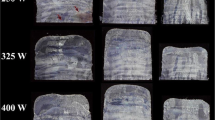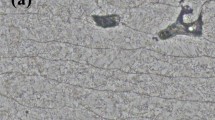Abstract
Integrated Materials and Products Design (IMPD) is a new system-based design approach. This emerging method focuses on designing a product and its materials at the same time to further enhance product performances. In the process of IMPD, material models that predict material properties with given inputs of material processing parameters play an important role in numerous design optimization iteration loops. In this work, a material model for predicting the tensile strength of austenitic stainless steels is developed based on the neural network with Bayesian framework. Using the Bayesian framework, we quantify the degree of uncertainty, originated from lack of data or the architecture of employed neural network, in the prediction of material properties. This quantification is very important for the later use in robust design optimization. Developed material model is validated based on the two different types of austenitic stainless steels, AISI 316L and AISI 347H, subjected to prior heat treatment processes. Comparing the predicted results with experimental results, we observe our material model predicts the tensile strengths of AISI 316L steels heattreated at various temperatures with higher levels of accuracy. The predicted tensile strengths of AISI 347H steels tested at different temperatures are reasonably close to the experimental results.
Similar content being viewed by others
Abbreviations
- x i :
-
inputs to the hidden layer of the artificial neural network
- w ij :
-
weights of the inputs
- v i :
-
outputs from the hidden layer
- b i :
-
biases
- w i :
-
weights of the outputs from the hidden layer
- Y :
-
output from of the artificial neural network
- E D :
-
overall fitting error
- t i :
-
target for a set of input
- y i :
-
corresponding output of the input set from the artificial neural network
- E W :
-
regulariser to prevent overfitting
- m :
-
number of training data set
- n :
-
the number of weights
References
Ashby, M. F., “Materials Selection in Mechanical Design,” Butterworth-Heinmen, pp.17–19, 2004.
Choi, H., McDowell, D. L., Allen, J. K., Rosen, D., and Mistree, F., “An Inductive Design Exploration Method for Robust Multiscale Materials Design,” Journal of Mechanical Design, Vol. 130, No. 3, pp. 031402, 2008.
Olson, G. B., “Computational Design of Hierarchically Structured Materials,” Science, Vol. 277, No. 5330, pp. 1237–1242, 1997.
Kim, H. M., Michelena, N. F., Papalambros, P. Y., and Jiang, T., “Target Cascading in Optimal System Design,” Journal of Mechanical Design, Vol. 125, No. 3, pp. 474–480, 2003.
McDowell, D. L., “Modeling and Experiments in Plasticity,” International Journal of Solids and Structures, Vol. 37, No. 1, pp. 293–309, 2000.
Cha, D. J., Kim, D. K., Cho, J. R., and Bae, W. B., “Hot Shape Forging of Gas Turbine Disk Using Microstructure Prediction and Finite Element Analysis,” Int. J. Precis. Eng. Manuf., Vol. 12, No. 2, pp. 331–336, 2011.
Yang, Z. J., Yu, H. S., Yang, S. M., Song, J. H., and Park, S. Y., “Prediction of Steady-state Creep Strain Rate and Rupture Life for SnAg-based Lead-free Solder Joints by SP Test,” Int. J. Precis. Eng. Manuf., Vol. 14, No. 7, pp. 1245–1250, 2013.
Kuehmann, C. and Olson, G., “Computational Materials Design and Engineering,” Materials Science and Technology, Vol. 25, No. 4, pp. 472–478, 2009.
Bhadeshia, H. K., “Neural Networks in Materials Science,” ISIJ International, Vol. 39, No. 10, pp. 966–979, 1999.
University of Cambridge, “Materials Algorithms Project,” http://www.msm.cam.ac.uk/map/mapmain.html (Accessed 10 Dec 2013)
Sourmail, T., “Precipitation in Creep Resistant Austenitic Stainless Steels,” Material Science and Technology, Vol. 17, No. 1, pp. 1–14, 2001.
MacKay, D. J. C., “A Practical Bayesian Framework for Backpropagation Networks,” Neural Comput., Vol. 4, No. 3, pp. 448–472, 1992.
Miles, W. J., “Fracture Toughness of Type 304 and 316 Stainless Steels and Their Weld,” International Materials Reviews, Vol. 42, No. 2, pp. 45–82, 1997.
Song, Y., Baker, T. N., and McPherson, N. A., “A Study of Precipitation in as-welded 316LN Plate Using 316L/317L Weld Metal,” Materials Science and Engineering:A, Vol. 212, No. 2, pp. 228–234, 1996.
Kozuh, S., Gojic, M., and Kosec, L., “The Effect of Annealing on Properties of AISI 316L Base and Weld Metal,” Materials and Geoenvironment, Vol. 54, No. 3, pp. 331–344, 2007.
Sourmail, T., Bhadeshia, H. K. D. H., and MacKay, D. J. C., “Neural Network Model of Creep Strength of Austenitic Stainless Steel,” Materials Science and Technology, Vol. 18, No. 6, pp. 655–663, 2002.
Gardi, R. H., “Tensile Strength Determination of Heat Treated Austenitic Stainless Steel AISI 316L Using (ABI) Method,” Al-Rafidain Engineering Journal, Vol. 20, No. 2, pp. 98–105, 2012.
Author information
Authors and Affiliations
Corresponding author
Rights and permissions
About this article
Cite this article
Wimarshana, B., Ryu, J. & Choi, HJ. Neural network based material models with Bayesian framework for integrated materials and product design. Int. J. Precis. Eng. Manuf. 15, 75–81 (2014). https://doi.org/10.1007/s12541-013-0307-4
Received:
Accepted:
Published:
Issue Date:
DOI: https://doi.org/10.1007/s12541-013-0307-4




